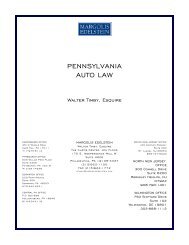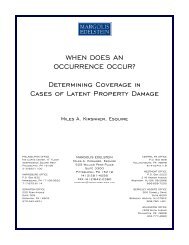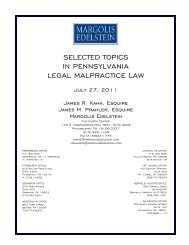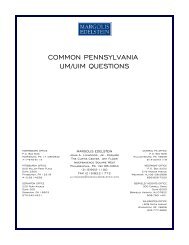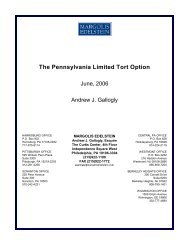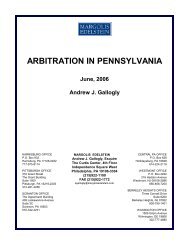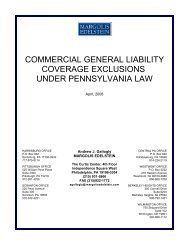recent developments in pennsylvania medical malpractice law
recent developments in pennsylvania medical malpractice law
recent developments in pennsylvania medical malpractice law
You also want an ePaper? Increase the reach of your titles
YUMPU automatically turns print PDFs into web optimized ePapers that Google loves.
vegetative state was endur<strong>in</strong>g pa<strong>in</strong> and suffer<strong>in</strong>g. It held <strong>in</strong> Freed v. Geis<strong>in</strong>ger Medical Center, 910A.2d 68 (Pa. Super. 2006) that a nurse could not only testify as to the standard of care for a treat<strong>in</strong>gnurse, but could also op<strong>in</strong>e regard<strong>in</strong>g the causative relationship between breaches of the nurs<strong>in</strong>gstandard of care for an immobilized patient and the development of pressure sores.In Jacobs v. Chatwani, 922 A.2d 950 (Pa. Super. 2007), the Superior Court noted that thestandard of <strong>medical</strong> certa<strong>in</strong>ty for a defense expert <strong>in</strong> her testimony is less than for a pla<strong>in</strong>tiff’s expert.Thus, a defense expert could op<strong>in</strong>e that there was a “possible” alternative cause of the pla<strong>in</strong>tiff’scondition without certa<strong>in</strong>ty as rebuttal to pla<strong>in</strong>tiff’s causation theory s<strong>in</strong>ce the pla<strong>in</strong>tiff has the burdenof prov<strong>in</strong>g causation.The Superior Court <strong>in</strong> Katz v. St. Mary Medical Center, 816 A.2d 1125 (Pa. Super. 2003) heldthat the defendant physician could state <strong>medical</strong> op<strong>in</strong>ions without there hav<strong>in</strong>g been an expert reportabout them as long as those op<strong>in</strong>ions were not acquired as part of the litigation but rather derived fromthe underly<strong>in</strong>g events. Disclosure may still be needed if the defendant physician is go<strong>in</strong>g to testify basedupon observations from subsequent treat<strong>in</strong>g records.There have been several <strong>recent</strong> cases regard<strong>in</strong>g the submission of expert reports that are late.In Wollach v. Aiken, 815 A.2d 594 (Pa. 2002), the Supreme Court upheld the summary judgment forthe failure to produce an expert report by a court deadl<strong>in</strong>e. Summary judgment was affirmed and it wasfound that the pla<strong>in</strong>tiff had acted <strong>in</strong> “an <strong>in</strong>dolent fashion” by ignor<strong>in</strong>g deadl<strong>in</strong>es blatantly. A summaryjudgment was also affirmed for failure of a pla<strong>in</strong>tiff to submit timely expert reports <strong>in</strong> Kurian v.Anisman, 851 A.2d 152 (Pa. Super. 2004). The court found that the defendant was prejudiced, anddist<strong>in</strong>guished an earlier Supreme Court hold<strong>in</strong>g <strong>in</strong> Gerrow v. John Royle and Sons, 813 A.2d 778 (Pa.2002), which held that a late report would be permitted when there was no prejudice and extension ofa discovery timetable would have been permissible. In Downey v. Crozer-Chester Medical Center, 817A.2d 517 (Pa. Super. 2003), app. den’d., 842 A.2d 406 (Pa. 2004), the Superior Court allowed a latereport which was simply a supplemental one, but still affirmed the summary judgment based on the factthat the report did not provide sufficient basis for the claim. In Jacobs v. Chatwani, 922 A.2d 950 (Pa.Super. 2007), a late expert report was allowed as the delay was found by the trial court not to beprejudicial. That case also noted that an expert can be cross-exam<strong>in</strong>ed about a treatise only if he reliedon it <strong>in</strong> form<strong>in</strong>g his op<strong>in</strong>ion or admits that it is authoritative or a “standard work <strong>in</strong> the field”.In Schweikert v. St. Luke’s Hosp., 886 A.2d 265 (Pa. Super. 2005), the Superior Court upheldpreclusion at trial of a <strong>medical</strong> expert theory which had not been identified <strong>in</strong> the expert’s report. InFreed v. Geis<strong>in</strong>ger Medical Center, 910 A.2d 68 (Pa. Super. 2006), a trial court’s decision was upheldwhere an expert’s testimony was precluded because the expert’s pre-trial report did not state hisop<strong>in</strong>ion to a reasonable degree of <strong>medical</strong> certa<strong>in</strong>ty. In W<strong>in</strong>schel v. Ja<strong>in</strong>, 925 A.2d 782 (Pa. Super.2007), the Superior Court reiterated the requirement that expert testimony must <strong>in</strong>dicate at some po<strong>in</strong>tdur<strong>in</strong>g her testimony that f<strong>in</strong>d<strong>in</strong>gs were made to a reasonable degree of scientific certa<strong>in</strong>ty, though neednot testify as to absolute certa<strong>in</strong>ty or rule out all possible alternative explanations; the court specificallyheld that testimony about what “might have” occurred is not permitted. However, <strong>in</strong> Vicari v.Spiegel, 2007 Pa. Super. 316 (Pa. Super. 2007), the court held that the totality of the testimony wassufficient to show a reasonable degree of <strong>medical</strong> certa<strong>in</strong>ty even though the expert had testified that thetherapy not received “may have prevented” the illness <strong>in</strong> question.-13-



